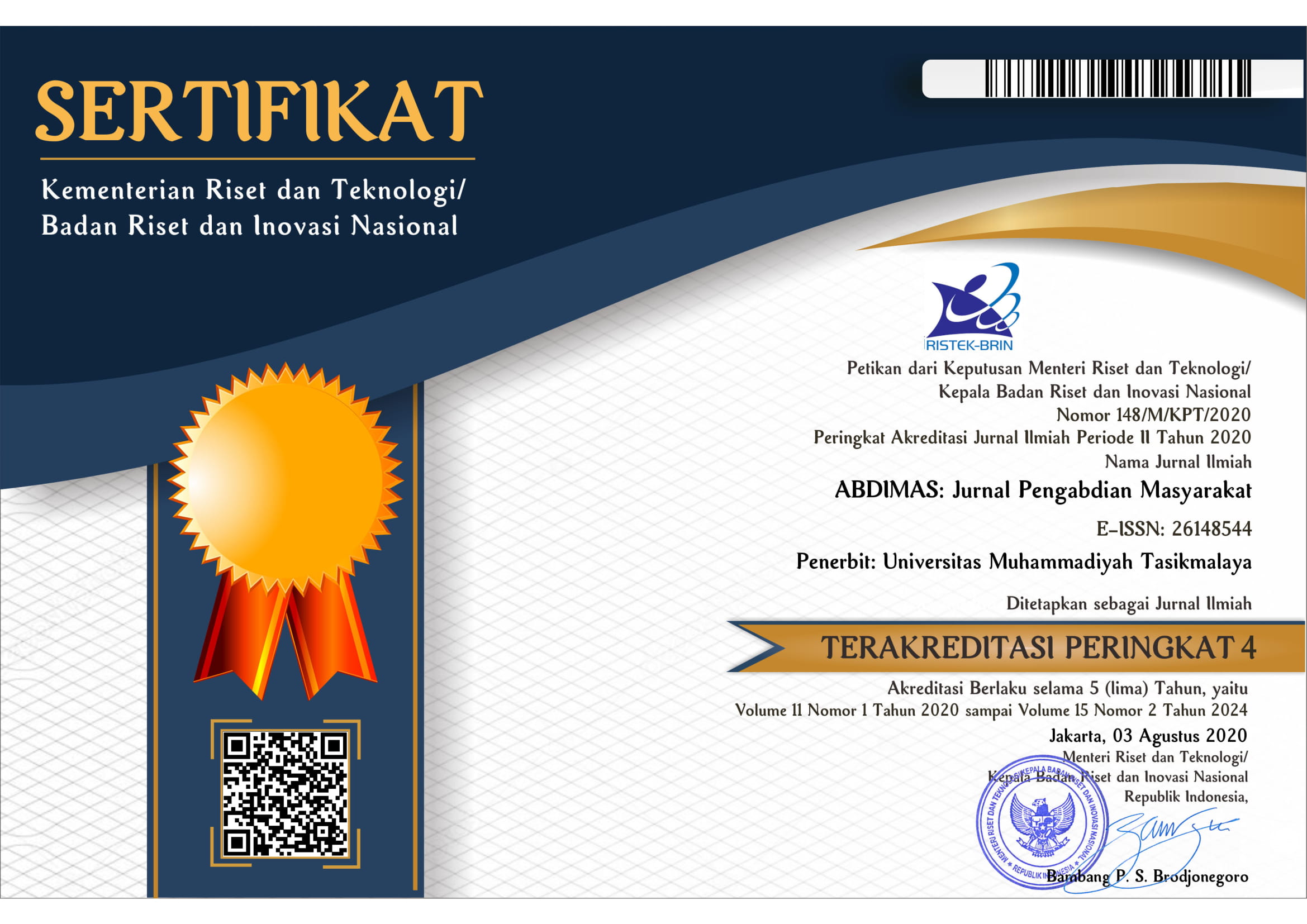Innovative Floating Latrine Technology Solutions for Regions Island Sinjai Regency, South Sulawesi Province, Indonesia
DOI:
https://doi.org/10.35568/abdimas.v6i2.3003Keywords:
Pulau Sembilan, Pesisir, Sanitasi, Jamban Terapung/Pasang SurutAbstract
Ownership of toilets has long been an environmental sanitation problem in the coastal areas of Sembilan Island which are generally inhabited by residents with improper domestic wastewater (black water) treatment. Most of the people in the area use a “slung” type of toilet in their house, which results in direct contacts of their domestic wastewater, such as black water or feces, with nearby bodies of water. Additionally, these coastal communities openly defecate in the seafront at night. The implementation of community service is carried out in 4 stages, namely: socialization of innovative technology and FGDs, workshops, training in making innovative floating latrine technology, and assistance in installing floating/tidal latrines. The socialization was carried out at the sub-district level by inviting residents and related stakeholders, which was then followed by FGDs to explore problems and find solutions to sanitation-related issues. The workshop was conducted by making a manual for the management of floating/tidal latrines. The training on making floating/tidal latrine technology is only for the residents of Pulau Sembilan. Lastly, assistance was provided for the installation of floating latrines in a predetermined location. This community service resulted in the development of innovative floating / tidal latrine technologies that meet sanitation standards, making it easier for residents of Pulau Sembilan to defecate without violating health and hygiene standards. This technology has also been successfully developed and implemented at a relatively affordable cost with the hope that this innovation can be easily duplicated by other communities in Pulau Sembilan.
Downloads
References
Anggraini, N. (2011). Aplikasi Teknologi Pengomposan Berbasis Partisipasi Masyarakat. Universitas Gajah Mada.
Bhatt N, Budhathoki SS, Lucero-Prisno DEI, Shrestha G, Bhattachan M, Thapa J, et al. (2019) What motivates open defecation? A qualitative study from a rural setting in Nepal. PLoS ONE 14(7): e0219246. https://doi.org/10.1371/journal.pone.0219246
Departemen Kesehatan Republik Indonesia. (2009). Rencana Pembangunan Jangka Panjang Bidang Kesehatan 2005-2025.
Hindun, I., Mulyono, M., & Husamah, H. (2019). Pemanfaatan Teknologi Tepat Guna Berbasis Solar Cell untuk Mengatasi Permasalahan IRT Nelayan Sapeken Kabupaten Sumenep. International Journal of Community Service Learning, 3(4), 198. https://doi.org/10.23887/ijcsl.v3i4.21791
Immurana M, Kisseih KG, Yusif HM, Yakubu ZM (2022) The effect of financial inclusion on open defecation and sharing of toilet facilities among households in Ghana. PLoS ONE 17(3): e0264187. https://doi.org/10.1371/journal.pone.0264187
Khaer, A. (2019). Rancang Bangun Jamban Terapung.
Kurniawati, R. D., & Saleha, A. M. (2020). Analisis Pengetahuan, Sikap dan Peran Petugas Kesehatan dengan Keikutsertaan dalam Stop BABS. 9(2), 99–108.
Peraturan Menteri Kesehatan Republik Indonesia, Pub. L. No. 3 (2014).
Mukherjee, N. (2011). Factors Associated with Achieving and Sustaining Open Defecation Free Communities : Learning from East Java.
Musadad, D. A. (2019). rekayasa sosial dan teknologi tepat guna untuk penyelesaian masalah sanitasi. In Paper Knowledge . Toward a Media History of Documents (Vol. 5, Issue 2).
Noor, R. (2011). T-Pikon-H Sebagai Teknologi Alternatif Untuk Perbaikan Sanitasi di Daerah Spesifik Rawa. Info Teknik, 12(2), 61–74.
Novita, R. (2020). Kajian literatur: Dampak perubahan iklim terhadap timbulnya penyakit tular nyamuk terutama Limfatik Filariasis. Journal of Health Epidemiology and Communicable Diseases, 5(1), 30–39. https://doi.org/10.22435/jhecds.v5i1.1583
Pokja AMPL Kabupaten Sinjai. (2016). Dokumen Pemutakhiran Strategi Sanitasi Kabupaten (SSK) Kabupaten Sinjai.
Purwati, S. U., & Aryantie, M. H. (2016). Profil Masyarakat Dan Lingkungannya Sebagai Modal Membangun Peran Serta Masyarakat Dalam Upaya Pencegahan Pencemaran Lingkungan. Jurnal Ecolab, 10(2), 58–69. https://doi.org/10.20886/jklh.2016.10.2.58-69
Saparina, T., & Ali, L. (2021). Pembuatan Septic Tank Komunal Solusi Kesehatan Bagi Masyarakat Pesisir Desa Bokori Kecamatan Soropia Making Communal Septic Tanks , Health Solutions for Coastal Communities , Bokori Village , Soropia District Menurut laporan Join Monitoring Soropia Kabupa. 2(1), 33–39.
Standar Nasional Indonesia 2398-2002. (2002). SNI 03-2398-2002 tentang Tata Cara Perencanaan Tangki Septik dengan Sistem Resapan. Standar Nasional INdonesia, 2002, 2399.
Sumampouw, O. J. (2019). Iklim Perubahan dan Kesehatan Masyarakat ( amira zdatin Nabila (ed.)). penerbit deepublish.
Yenni Amira, A., Sudiro, & Asmita Wigati, P. (2015). Evaluasi Pelaksanaan Sosialisasi Program Jaminan Kesehatan Nasional dari Aspek Struktur dan Interaksi Sosialisasi Pada Bulan Januari-Maret 2014. Jurnal Kesehatan Masyarakat (e-Journal), 13(3), 1576–1580.
Yuningsih, R. (2019). Strategi Promosi Kesehatan dalam Meningkatkan Kualitas Sanitasi Lingkungan. Aspirasi: Jurnal Masalah-Masalah Sosial, 10(2), 107–118. https://doi.org/10.46807/aspirasi.v10i2.1391
Zuraini, J. A. (2017). Strategi Perubahan Perilaku Pemilihan jamban dan Septic Tank di Permukiman Daerah Rendah (Studi Kasus Kota di Banjarmasin). JURNAL KESEHATAN LINGKUNGAN: Jurnal Dan Aplikasi Teknik Kesehatan Lingkungan, 14(2), 503. https://doi.org/10.31964/jkl.v14i2.71












